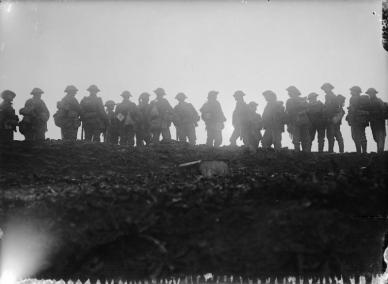 At Flers Courcelette, the Battle of the Somme: Courtesy of the Imperial War Museum,
At Flers Courcelette, the Battle of the Somme: Courtesy of the Imperial War Museum,
http://www.iwm.org.uk/collections/item/object/205193934
As any fan of The Lord of the Rings [LOTR] trilogy will attest, much of JRR Tolkien’s writings were influenced, if not shaped, by the First and Second World Wars. A striking example of this can be seen in his description of the Dagorlad Battlefield or commonly known as the Dead Marshes of Mordor, in The Two Towers. The connection between Tolkien’s writings and his experiences in the First World War, particularly the Battle of the Somme, has been debated by scholars of various disciplines. Although most agree that wartime experiences contributed to his creation of Middle-Earth, others proclaim that his writings were mostly a product of his studies of the classics, ancient languages and Old Norse folklore. Thus the argument lies therein.
[For a current read on this debate, see John Garth’s Web site for a link to Tolkien and the Great War: The Threshold of Middle-Earth: http://www.johngarth.co.uk/php/tolkien_and_the_great_war.php]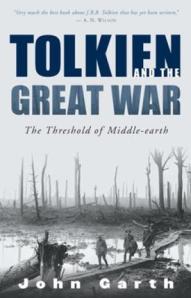 Yet the recurring theme of war, caused by the weakness for power and greed and the resultant loss of the natural environment, is a common narrative in Tolkien’s writings. It is this theme that causes the reader to be reminded of how conflict can set off the delicate balance of all living things in the natural world. As a primary actor in the theatre of war, surely Tolkien’s experience in the Battle of the Somme seems more likely to have provided the fodder for the conceptual framework behind the LOTR, than his academic background.
Yet the recurring theme of war, caused by the weakness for power and greed and the resultant loss of the natural environment, is a common narrative in Tolkien’s writings. It is this theme that causes the reader to be reminded of how conflict can set off the delicate balance of all living things in the natural world. As a primary actor in the theatre of war, surely Tolkien’s experience in the Battle of the Somme seems more likely to have provided the fodder for the conceptual framework behind the LOTR, than his academic background.
J.R.R. Tolkien, 1916
Like many of his friends and collegues from Oxford University, Tolkien signed up to ‘do his bit’ for the war cause and joined the Lancashire Fusiliers.
[For a “Biographical Sketch” of J.R.R. Tolkien, go to a member’s collective whose contributions are approved through the Society’s Executive Committee: http://www.tolkiensociety.org/tolkien/biography.html alternatively the Tolkien Library offers a basic biography as well as other information pertaining to the author and his works: http://www.tolkienlibrary.com/abouttolkien.htm]
Shortly after, Tolkien was sent to the Western front in 1916 where he served as a signal officer at the Battle of the Somme.
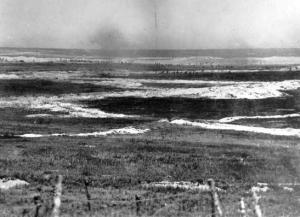 Troops attacking during the Battle of the Somme:
Troops attacking during the Battle of the Somme:
Photograph courtesy of the Imperial War Museum, London.
The Book of Lost Tales written during his convalescence in a Birmingham military hospital, provided the framework for the concept of ‘Middle-Earth’, and would eventually be used in the LOTR. The narrative of the Dead Marshes can be found in the second volumn of The Lord of the Rings titled: The Two Towers which was released on November 11 1954, the date befitting of war rememberance.
With 415,000 British and 650,000 German troops killed during this particular battle, including all but one of Tolkien’s closest friends, it stands that memories of the landscape would leave a lasting impression and provide the details for his writings.
Caught between two worlds, no-man’s land, like the Dead Marshes was a barren landscape, devoid of all life. In The Two Towers, book-2 of the LOTR trilogy, Tolkien sought to create a setting reminiscent of the devastation and impact of war. The features of the Dead Marshes are strikingly similar to the accounts of the trenches at the Somme. The atmosphere of the Dead Marshes is one of battles long past, of suffering and a level of destruction resulting in a perpetual emptiness, a type of soulless vacuum. In some ways, Tolkien’s knowledge and study of religion is apparent if one interprets the Dead Marshes as a type of ‘Purgatory’ for the souls of the un-dead. In the trenches, Tolkien would have experienced the daily infestation of lice, rats and corpses floating above the mud and rain-filled craters created by shell fire. This vision of life in the trenches is clearly depicted in the Dead Marshes as seen in the following passage:
“…the marsh-reeks lay in heavy banks. No sun pierced the clouded sky…a shadowy silent world…an endless network of pools, and soft mires, and winding half-strangled water-courses. It was dreary and wearisome. Cold clammy winter still held sway in this forsaken country. The only green was the scum of livid weed on the dark greasy surfaces of the sullen waters. Dead grasses and rotting reeds loomed up in the mists like ragged shadows of long-forgotten summers”. J.R.R. Tolkien, The Two Towers: The Passage of the Marshes (London: Unwin Paperbacks, 1954), 288-289.
[The original 1954 edition is not easily accessible digitally, however, a hard copy can be found in most local libraries. For a quick scan of the above quote, go to: http://www.greatwar.nl/frames/default-tolkienfragmente.html. *Note, this online version is from the 1991 edition by HarperCollins]
Amongst a thick veil of wet and rot is a quiet yet constant hum of lost souls waiting to redeem themselves, to tell their story. This is the very essence of the Dead Marshes; a poignant lament for the dead and perhaps for the lives of Tolkien’s friends. Based upon the 4 images below, it is not difficult to see how Tolkien’s experiences at the Battle of the Somme played a vital role in creating the Dead Marshes landscape.
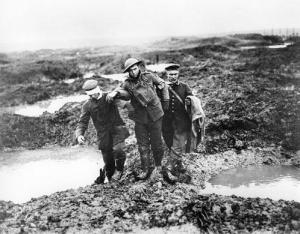 Battle of the Somme, Courtesy of:
Battle of the Somme, Courtesy of:
http://sidneyroundwood.blogspot.com/2011/07/flooded-land.html
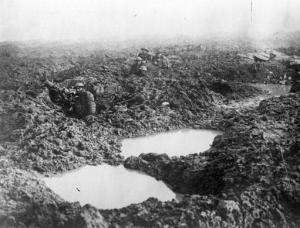 Battle of the Somme, Courtesy of:
Battle of the Somme, Courtesy of:
http://sidneyroundwood.blogspot.com/2011/07/flooded-land.html
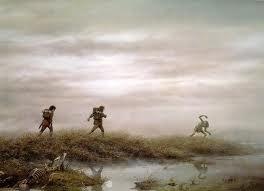 Dead Marshes, Courtesy of Artist Ted Nasmith:
Dead Marshes, Courtesy of Artist Ted Nasmith:
http://www.greatwar.nl/frames/default-tolkienfragmente.html
&
http://tolkiengateway.net/wiki/Dead_Marshes
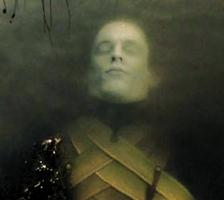 The Dead Elf-King, Courtesy of:
The Dead Elf-King, Courtesy of:
http://lotr.wikia.com/wiki/File:Dead_Ones.png
[For an introduction to the Dead Marshes as it is depicted in The Two Towers, go to the Tolkien Gateway Web site: http://tolkiengateway.net/wiki/Dead_Marshes]
About the Film:
Far from the trenches of the Somme, director Peter Jackson wrote and produced the film adaptation of The Lord of the Rings trilogy from the desolate bogs of Kepler Mire in New Zealand’s South Island.
[For a quick look at the Dead Marshes scene from The Two Towers, click on the following clip: http://www.youtube.com/watch?v=nPrJSRMr2Uc]
[For a sneak peak at the 2012 film release of The Hobbit: An Unexpected Journey, click on The Hobbit: An Unexpected Journey, Trailer 1: http://www.thehobbitblog.com/?p=4353]
The Somme on Film:
For an interesting look at the Battle of the Somme produced by an independent film company: http://www.yapfilms.com/what/history_page3.html
&
http://www.youtube.com/watch?v=KgPcko8XLKE&feature=related
Additional links to Tolkien and the Battle of the Somme:
- See BBC journalist Lisa Jardine’s report from the BBC News Online, July 2006; Quoting Jardine’s take on the effect of war on Tolkien’s writings: “When he describes the desolation of the battlefield, strewn with the mangled corpses of friend and foe, at the end of combat, we sense that Tolkien has himself witnessed that bleak devastation”. http://news.bbc.co.uk/2/hi/uk_news/magazine/5133000.stm
- The Imperial War Museum for a brief look at Tolkien’s wartime experience: http://archive.iwm.org.uk/server/show/nav.2211
- For an extensive collection of resources on the Battle of the Somme, click on the links provided: http://archive.iwm.org.uk/server/show/nav.2289
- For an interesting discussion of the connection between the Somme and the Dead Marshes, go to: http://www.greatwar.nl/frames/default-tolkienfragmente.html. This site is created and edited by two Dutch writers, Nic van Holstein & Rob Ruggenberg which includes a few links to primary source documents. *Note that the rest of the site expresses opinions which may not be shared by the academic community.
- [For a detailed look at the geography of Middle-earth, Mordor and the Dead Marshes, click on Maps: http://www.lord-of-the-rings.org/collections/maps.html]
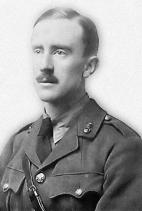
One response to “Tolkien’s Dead Marshes and the Battle of the Somme: A Guide to Online Resources”
[…] narrative of the Second World War. (Even if there’s a convincing argument to be made that Tolkien was just as inspired by his experiences in the First World War as what was unfolding in Europe when he wrote The Lord of the Rings.) Jackson cleverly […]
LikeLike